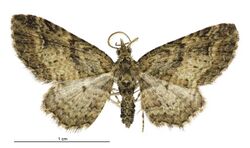Biology:Pasiphila charybdis
| Pasiphila charybdis | |
|---|---|

| |
| Scientific classification | |
| Domain: | Eukaryota |
| Kingdom: | Animalia |
| Phylum: | Arthropoda |
| Class: | Insecta |
| Order: | Lepidoptera |
| Family: | Geometridae |
| Genus: | Pasiphila |
| Species: | P. charybdis
|
| Binomial name | |
| Pasiphila charybdis (Butler, 1879)[1]
| |
| Synonyms[2] | |
| |
Pasiphila charybdis is a species of moth in the family Geometridae. It is endemic to New Zealand.[1][3]
Taxonomy
This species was first described by Arthur Gardiner Butler in 1879 and named Helastia charybdis using specimens collected by F. W. Hutton in Dunedin.[4][2] In 1879, thinking he was describing a new species, Butler also named this species Helastia calida.[4] George Hudson, also thinking he was describing a new species, named it Chloroclystis antarctica in 1898.[5] In 1917 Meyrick placed this species within the genus Chloroclystis and synonymised Helastia calida with it.[6] Hudson discussed Chloroclystis charybdis in his 1928 book The butterflies and moths of New Zealand but said he was unacquainted with the species.[7] In 1971 John S. Dugdale placed this species in the genus Pasiphila.[8] Dugdale confirmed this placement in 1988 and synonymised C. antarctica with P. charydbis.[2] The male holotype specimen is held at the Natural History Museum, London.[2]
Description
Hudson described the larvae of this species as follows:
The larva of this species, which feeds on the common Veronica in December, is, when full-grown, about 3⁄4 in. in length, rather attenuated anteriorly, almost uniform, dark reddish-brown, darker on the sides. The head is reddish, and there are traces of several longitudinal lines in younger larvae. Others are dull yellowish-brown, with the lines plainer and the prolegs pale-yellow ; but as the larva is so extremely variable a detailed description hardly appears possible.[9]
Butler described the adults of this species as follows:
primaries above smoky-grey, crossed by about eight zigzag blackish lines in pairs, forming indications of four bands which are most strongly defined upon the costa ; a whitish-edged black lunule between the last two bands ; the last band partially filled in with sandy-whitish and brown ; fringe whitish flesh-coloured intersected by a grey line and interrupted at the terminations of the veins by blackish spots; secondaries pale smoky-grey, the veins black spotted with whitish ; extreme outer margin black ; fringe as in the primaries ; body brownish-grey, head yellowish ; antennae smoky-grey, strongly pectinated ; under surface sericeous grey ; markings of upper surface ill-defined ; discocellulars black ; primaries with pale reddish cupreous costal area; secondaries with a series of short black dashes beyond the cell; fringe paler than the rest of the wings, spotted with dark grey. Expanse of wings 10 1⁄2 lines.[4]
When discussing this species Dugdale stated:
Habitat and hosts
The larval hosts of this species are plants in the genus Veronica.[9] Larvae have been successfully raised on Hebe
Life cycle
The pupa of this species can be found enfolded with silk between two leaves of its larval host.[9] The adults of this species are on the wing from December.[9]
References
| Wikimedia Commons has media related to Pasiphila charybdis. |
- ↑ 1.0 1.1 "Pasiphila charybdis (Butler, 1879)". Landcare Research New Zealand Ltd. http://www.nzor.org.nz/names/b93bd92a-90f2-41c3-afb5-9374c49e852c.
- ↑ 2.0 2.1 2.2 2.3 2.4 , pp. 187, Wikidata Q45083134
- ↑ , p. 460, Wikidata Q45922947
- ↑ 4.0 4.1 4.2 , pp. 503-504, Wikidata Q104215588
- ↑ , pp. 42, Wikidata Q19073637
- ↑ , pp. 253, Wikidata Q110727829
- ↑ , pp. 93, Wikidata Q58593286
- ↑ , Wikidata Q64006453
- ↑ 9.0 9.1 9.2 9.3 , pp. 360, Wikidata Q113503791
Wikidata ☰ Q13879044 entry
 |


